Don Kelbick's 2-2-1 Zone Pressure
This 2-2-1 zone press is an extension of my match-up zone. As we move up the floor with our defense, the basic match-up rules stay in force, just move up the floor.

Look at the basic zone and then stretch it.

We start in the basic matchup zone set and stretch it up the floor.
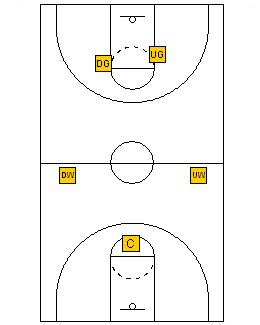
Here is the positioning after stretching the zone.
The responsibilities in the full court set are the same as in the half court.
You can see that our match-up has become a 2-2-1.
Defensive Philosophy
Before you put your players on the court to execute, you must develop and sell your philosophy. Teams that execute plays without supporting philosophy are doomed to fail. Even in my 2-2-1 pressure, my philosophy is consistent.
My definition of defense is an action that prevents the other team from scoring. I say it in the quarter court, in the half court and in the full court. I don′t care about turnovers, creating pace, traps, etc. Just don′t let them score.
I believe that the team that makes the most lay-ups wins. Do whatever is necessary to prevent a lay-up. How about that, here we are talking about pressure and preventing lay-ups in the same breath. Through all my formulative years as a coach, researching, going to clinics, watching others, I have been taught that lay-ups are a by-product of pressure.
Sure, you give up a few but you′ll get more in return. I don′t care. It is never okay to give up a lay-up.
There is nothing more damaging to your defense than a lay-up. It is a sure 2 points. They are demoralizing. They get your post players in foul trouble. They get your team in foul trouble. You can′t defend everything. In every defense, you have to choose what you are going to defend. I choose to defend lay-ups. Even in a pressure.
Purpose of the 2-2-1
The purpose of the 2-2-1 is to keep the offense off balance, thereby disrupting their offense. I want the offense constantly thinking about what we are doing defensively, not what they are doing offensively.
For most teams, the longer the offensive possession, the less efficient it is. Dribblers get impatient, shooters lose rhythm when the offense struggles to find pace.
If you play with a shot clock, figuring out the pressure uses precious time and again, robs your offense of its edge. If your offense has only 15 seconds to execute when they are used to 20 or more, it puts the offensive players under pressure and robs them of some of their decision making. Offenses start to beak down.
If you play with an 8 second rule in the backcourt, the offensive players are always under pressure to clear the mid-court line. Then, trying to get into an offensive thrust becomes a real problem.
Rules of the 2-2-1
The overall rules of the 2-2-1 are essentially the same as the match-up zone when it comes to defending players and assuming responsibility.
Let′s start with the basic match-up.

The basic matchup set.
Now we extend the match-up up the floor.
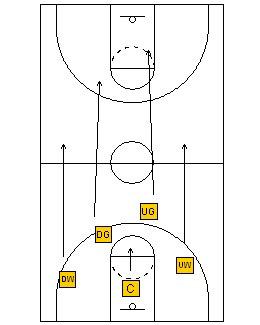
Extend the positions up the floor
The rules are still the same. The Up Guard plays the ball on top. The Up Wing plays the first pass on the up side, the Center plays the low post and the second pass on the “up” side. The Down Guard plays the ball on the down wing on the “down” side and the down wing plays the corner on the “down” side and the low post on the “up” side.
We still deny cutters to the ball and release cutters away from the ball. And surely, we still “bump.”

Here, the weak side forward flashes to the middle.
The down wing plays him until he runs into the down guard.
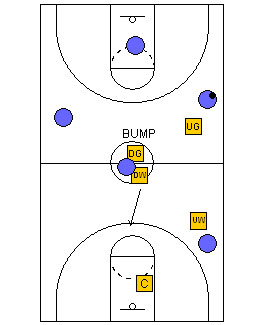
The down wing and the down guard "bump."
The down guard plays the cutter and the down wing returns to his responsibility.
2-2-1 Rule: Straight line, Circles
The next rule we have in the 2-2-1 is "straight line, circles."
"Straight line, circles," is the positioning phrase I use to get players in the right position on the weak side. Not only does it make the defense more effective but it helps us prevent lay-ups. The weak side guard should always be in the middle of the floor. He also uses the circles, foul circles and center court jump circle, as an aide to depth as he defends the weak side. I try to teach, you should always have one foot in a circle.
The objective is 2 fold. First, we always want to keep the ball out of the middle. Allowing the ball into the middle of a pressure has the same effect as letting the ball in the lane in your quarter court defense. It breaks down all your principles.
The second piece is I always want to keep the ball in front of the defense. By retreating into a circle on the Weak side, the weak side guard is always ahead of the ball.
The second line Weak side defenders (the wings) are in a straight line behind the guard and in the next circle. If the ball is on the baseline and the Weak side guard is in the middle of the court with his foot in the foul circle, the Weak side wing is directly behind him, with a foot in the center circle.

With the up wing involved on the ball, the down guard and the down wing are "straight line circles."
As the ball advances up the floor and both players retreat, the spacing adjusts accordingly, and the circles help with that. As the Weak side guards retreats, the Weak side wing adjusts his spacing in the center circle. At the point where the guard has retreated deep enough to have his foot in the center circle, the Weak side wing should have his foot in the foul circle.
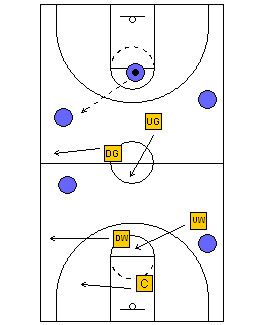
Weak side defenders recover laterally and stay ahead of the ball.
The other defenders run "straight line circles."
Transitioning to Half Court Defense
As the ball advances into the offensive area, the defensive players are in their proper positions for their match-up zone. The defense has now gone from their full court defense into their basket defense without the need to reset, leave the ball or expose the basket.
They have not given the offense the opportunity to relax and reset their possession. Time has gone by, the shot clock (if you play with one) is ticking and the offensive players are now under pressure to make a play. As long as that play isn′t a lay-up, the defense is in pretty good shape.
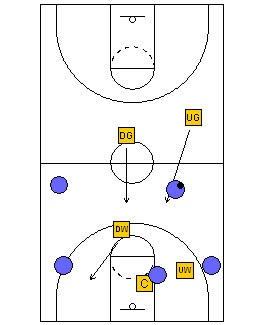
As the ball advances, a primary rotation is for the top defenders (UG and DG) must get ahead of the ball.
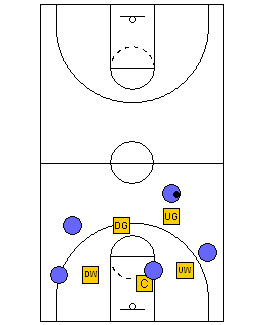
The defense settles into the matchup zone.
Controlling Tempo and Creating Turnovers with the 2-2-1
The purpose for my 2-2-1 zone press, in this system, is to keep the offense off balance.
We want to disturb their rhythm, interrupt the flow of their offense, run the shot clock (if you are at a level where you use a shot clock). I want them to take shots they do not want to take, have the ball in the hands of players who are not comfortable with the ball. It is the versatility of the 2-2-1 pressure that allows you to do so.
Anytime the offense has the ball in the backcourt, they will react. I want them to react differently each time down the floor. The basic 2-2-1 works like this. When the ball is inbounded, the “up” guard plays the ball on his side. He does not force the ball, but he tries to “influence” the ball handler to his side of the court and then plays him man to man. He does not play him hard and does not over-commit on the ball handler and he must not get beat on the dribble and certainly must not get beat to the middle. All we want is for the ball handler to pay more attention to the defender than he does to his receivers.
The down guard gets ahead of the ball and is in weak side help, preventing a middle pass and dribble penetration. The up wing guards the ball side sideline, the down wing is “straight line circle” behind the down guard, guarding against a penetrating pass to the middle, and the center is protecting the basket, shading the ball side.
When the offense sees defense in the backcourt, he expects a trap. The threat of the trap is what is going to keep the offense off balance.

The up guard puts pressure on the ball.
Other defenders position themselves as to not allow penetration or layups.
When the ball is reversed, the defense shifts. If the ball goes from the wing to the opposite wing, the down guard plays the ball, the up guard retreats, gets ahead of the ball and defends the middle. The up guard must make sure he gets ahead of the ball and the up wing does the same. The down wing adjusts to defend the ball side sideline. If there is an offensive man in the middle, he waits until he is bumped, either by the up guard or by the up wing. The center protects the basket and shades the ball side.
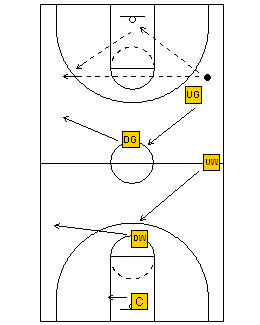
As they reverse, the defenders recover either laterally on the ball side, or diagonally toward their basket on the weak side.

Once again, the down guard puts pressure on the ball.
Notice the weak side defenders playing "straight line circles."
If the ball, when reversed, goes back to the point or the inbounder, we go back to our match-up zone rules. The up guard plays the ball on top. That means that the Up side is the ball side and the down side has help and middle responsibilities.

The up guard plays the ball in the middle and forces it to his side.
As the offense executes its patterns, remember the match-up zone rules; play the ball handler on the dribble until passed or bumped, deny cutters to the ball and release cutters away from the ball. As the ball comes up the floor, the defense continually adjusts.

If the ball is crossed on the pass. The strong side defenders recover so they can stay ahead of the ball.
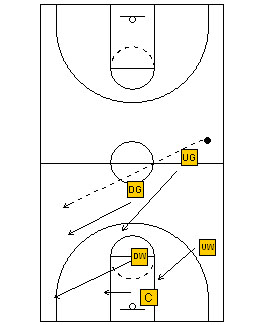
Again, recovery is up the floor and ahead of the ball.

As the ball enters the front court, the recovery allows for the defense to settle into the matchup zone.
As I have mentioned before, the most important part of your defense is your philosophy. The philosophy behind this pressure is to create a defensive mindset that you are going to play full court. After all, this is part of a full court, up tempo transition system. We want to interject our defense into the mind of the offense. We can take advantage of bad passes, sloppy play, and create poor tempo on offense which might translate into poor offensive play. If there is an offensive mishap, we already have offensive players near the basket for the transition to offense.
There is a lot of interpretation by the players in this defense. The coach determines the game plan, do we want to speed them up, slow them down, which players do we want to keep the ball away from, which ones to we want to direct the ball to?
The players now take that game plan and put it into action. The guards can “cat and mouse” with the ball handlers. Play them hard on one play, soft on another. You can play the passing lanes hard or deny the next logical receiver. In your scouting and in your practice, determine how you want to play it and turn the players loose.
2-2-1 Traps
The next step in the 2-2-1 pressure is the traps. Your basic defense is one of containment. The offense might even become complacent in attacking your defense. That doesn’t happen by accident. Your team, by virtue of how they have played the 2-2-1 pressure, may have created a false sense of security on the part of the offense. You really haven’t chased them or forced them into uncomfortable situations. You have actually lured them into a trap.
When the time is right, your defense can become a trapping ball hawking defense. Pick your spots. Don’t show it too much. You will be surprised at what you can create.
The best part of this match up defense is that you can turn it into a trapping defense without changing any basic responsibilities.
Trapping Areas
Where and how you trap becomes very important to the integrity of your defense. In this defense, we NEVER trap on the baseline or in the middle of the court.
There are essentially 2 trapping areas in this pressure -- on the sideline (just before mid-court) and just after crossing mid-court.

Trapping areas
I like to trap just before mid-court. I might be different in that regard. Many coaches don′t like to do that because the offense can pass the ball backward out of traps and reverse the ball. However, I have learned that good coaches, when they expect to be trapped once they cross mid-court, will set the offense in the backcourt, before they are under pressure and then break your trap and put the basket in danger.
By occasionally trapping before the offense crosses mid-court, the defense will keep the offense off balance and will be able to take advantage of the offensive strategy.
When trapping before or after mid-court, the trap involves the guard and wing on the same side, for example; up guard and up wing or down guard and down wing. If a player is not involved with a trap, his responsibilities do not change from those he executes in the basic defense.

Trapping on the up side always involves the up guard and the up wing.

On the "down" side, trapping over mid-court, the trap still involves the down guard and the down wing, just as it does in the backcourt.
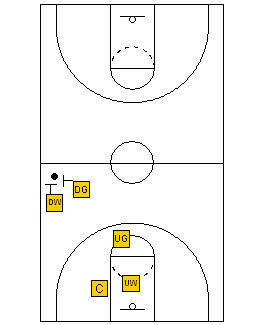
On the "up" side, trapping over mid-court, the trap still involves the up guard and the up wing, just as it does in the backcourt.
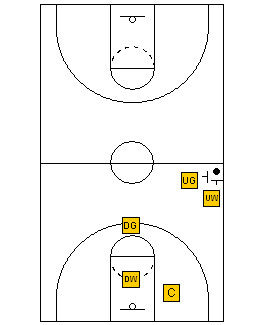
On the "up" side, trapping over mid-court, the trap still involves the up guard and the up wing, just as it does in the backcourt.
Even in traps, I will still do whatever I can to prevent a lay-up. Notice how the basket is protected when the defense is trapping. We may give up a jump shot but we will not give up a lay-up.
More Information and Helpful Resources
This 2-2-1 defense is an extension of Don Kelbick's match up zone defense. You can learn more about his match up defense and the 2-2-1 press on his match up defense DVD.
What do you think? Let us know by leaving your comments, suggestions, and questions...
|
|||||||||||



 Facebook (86k Likes)
Facebook (86k Likes) YouTube (131k Subscribers)
YouTube (131k Subscribers) Twitter (29.8k Followers)
Twitter (29.8k Followers) Q&A Forum
Q&A Forum Podcasts
Podcasts